Analyzing Environmental Health Determinants and Interventions in Slums
VerifiedAdded on 2023/06/13
|11
|3715
|149
Essay
AI Summary
This essay identifies and describes a slum area, highlighting environmental issues such as industrial pollution, poor sanitation, and socio-economic factors impacting the health of its 150,000 residents. It examines how these factors, including air and water pollution, lack of access to healthy food and healthcare, and social issues like alcohol abuse, contribute to health problems such as respiratory infections, obesity, and psychological disorders. The essay discusses existing interventions and proposes additional measures, including affordable housing, improved waste management, stricter industrial regulations, and community support networks to improve the health and well-being of the slum population. It emphasizes the need for data collection, identification of vulnerable populations, and the implementation of preventive strategies to mitigate long-term health effects.
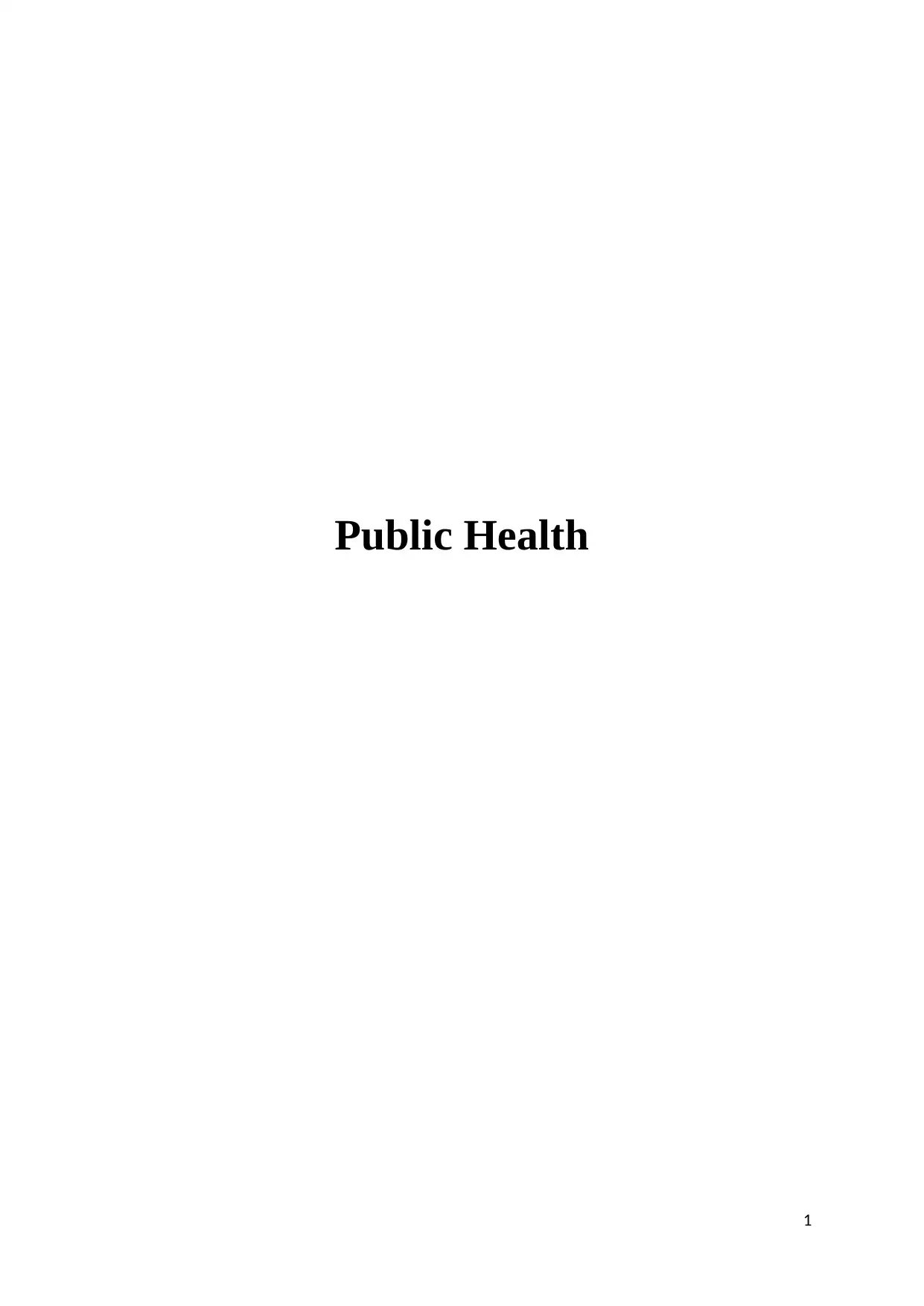
Public Health
1
1
Paraphrase This Document
Need a fresh take? Get an instant paraphrase of this document with our AI Paraphraser
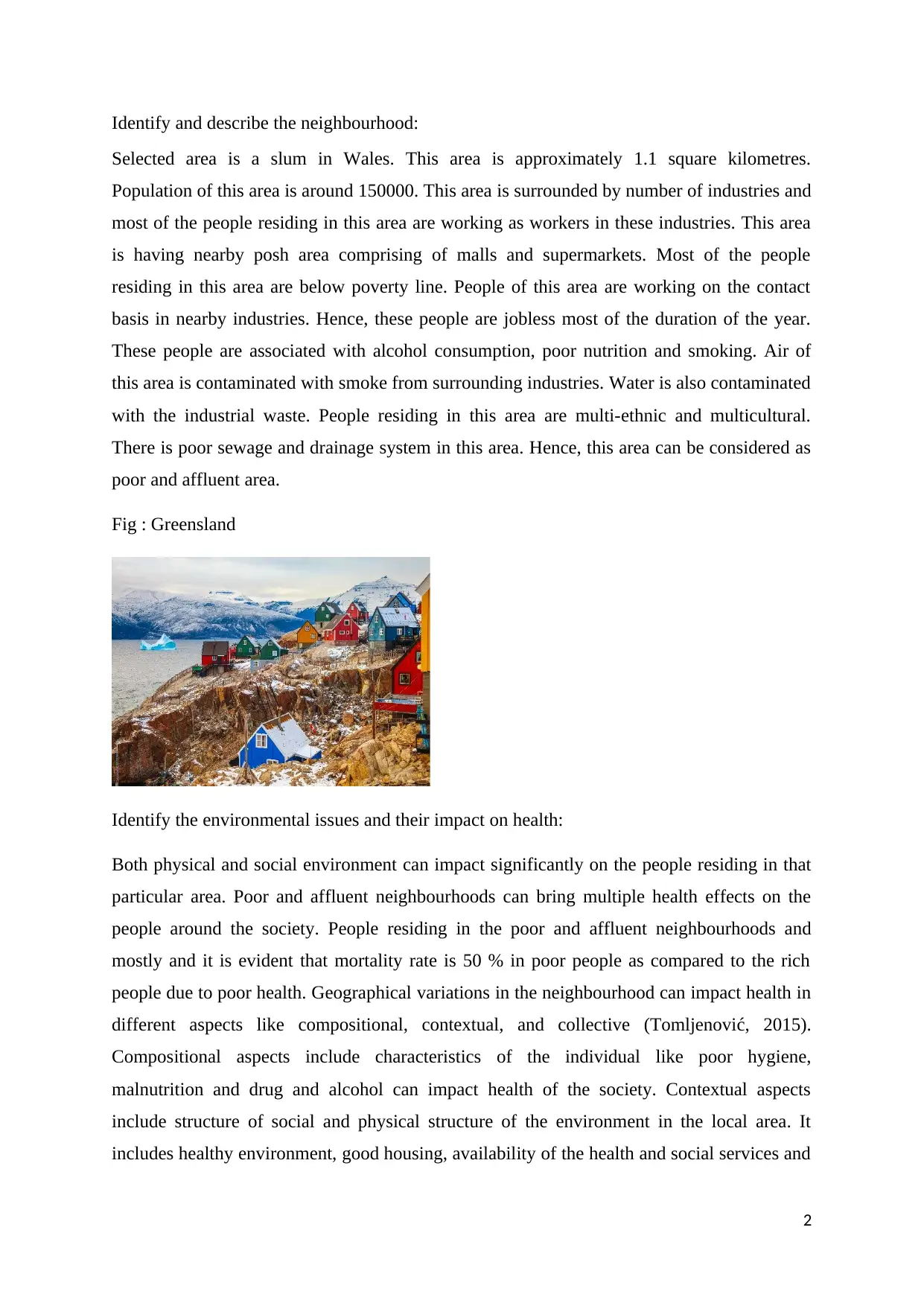
Identify and describe the neighbourhood:
Selected area is a slum in Wales. This area is approximately 1.1 square kilometres.
Population of this area is around 150000. This area is surrounded by number of industries and
most of the people residing in this area are working as workers in these industries. This area
is having nearby posh area comprising of malls and supermarkets. Most of the people
residing in this area are below poverty line. People of this area are working on the contact
basis in nearby industries. Hence, these people are jobless most of the duration of the year.
These people are associated with alcohol consumption, poor nutrition and smoking. Air of
this area is contaminated with smoke from surrounding industries. Water is also contaminated
with the industrial waste. People residing in this area are multi-ethnic and multicultural.
There is poor sewage and drainage system in this area. Hence, this area can be considered as
poor and affluent area.
Fig : Greensland
Identify the environmental issues and their impact on health:
Both physical and social environment can impact significantly on the people residing in that
particular area. Poor and affluent neighbourhoods can bring multiple health effects on the
people around the society. People residing in the poor and affluent neighbourhoods and
mostly and it is evident that mortality rate is 50 % in poor people as compared to the rich
people due to poor health. Geographical variations in the neighbourhood can impact health in
different aspects like compositional, contextual, and collective (Tomljenović, 2015).
Compositional aspects include characteristics of the individual like poor hygiene,
malnutrition and drug and alcohol can impact health of the society. Contextual aspects
include structure of social and physical structure of the environment in the local area. It
includes healthy environment, good housing, availability of the health and social services and
2
Selected area is a slum in Wales. This area is approximately 1.1 square kilometres.
Population of this area is around 150000. This area is surrounded by number of industries and
most of the people residing in this area are working as workers in these industries. This area
is having nearby posh area comprising of malls and supermarkets. Most of the people
residing in this area are below poverty line. People of this area are working on the contact
basis in nearby industries. Hence, these people are jobless most of the duration of the year.
These people are associated with alcohol consumption, poor nutrition and smoking. Air of
this area is contaminated with smoke from surrounding industries. Water is also contaminated
with the industrial waste. People residing in this area are multi-ethnic and multicultural.
There is poor sewage and drainage system in this area. Hence, this area can be considered as
poor and affluent area.
Fig : Greensland
Identify the environmental issues and their impact on health:
Both physical and social environment can impact significantly on the people residing in that
particular area. Poor and affluent neighbourhoods can bring multiple health effects on the
people around the society. People residing in the poor and affluent neighbourhoods and
mostly and it is evident that mortality rate is 50 % in poor people as compared to the rich
people due to poor health. Geographical variations in the neighbourhood can impact health in
different aspects like compositional, contextual, and collective (Tomljenović, 2015).
Compositional aspects include characteristics of the individual like poor hygiene,
malnutrition and drug and alcohol can impact health of the society. Contextual aspects
include structure of social and physical structure of the environment in the local area. It
includes healthy environment, good housing, availability of the health and social services and
2
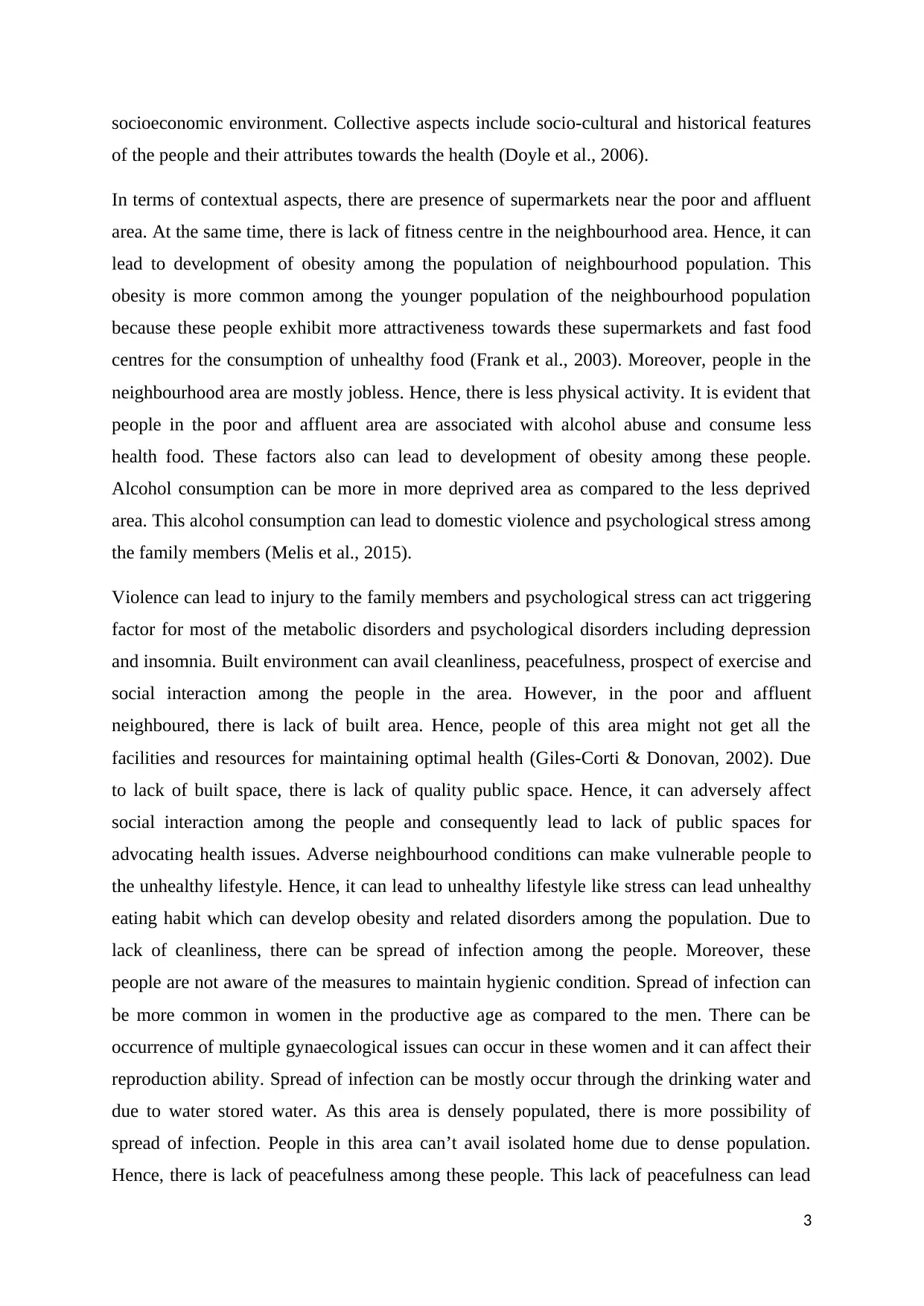
socioeconomic environment. Collective aspects include socio-cultural and historical features
of the people and their attributes towards the health (Doyle et al., 2006).
In terms of contextual aspects, there are presence of supermarkets near the poor and affluent
area. At the same time, there is lack of fitness centre in the neighbourhood area. Hence, it can
lead to development of obesity among the population of neighbourhood population. This
obesity is more common among the younger population of the neighbourhood population
because these people exhibit more attractiveness towards these supermarkets and fast food
centres for the consumption of unhealthy food (Frank et al., 2003). Moreover, people in the
neighbourhood area are mostly jobless. Hence, there is less physical activity. It is evident that
people in the poor and affluent area are associated with alcohol abuse and consume less
health food. These factors also can lead to development of obesity among these people.
Alcohol consumption can be more in more deprived area as compared to the less deprived
area. This alcohol consumption can lead to domestic violence and psychological stress among
the family members (Melis et al., 2015).
Violence can lead to injury to the family members and psychological stress can act triggering
factor for most of the metabolic disorders and psychological disorders including depression
and insomnia. Built environment can avail cleanliness, peacefulness, prospect of exercise and
social interaction among the people in the area. However, in the poor and affluent
neighboured, there is lack of built area. Hence, people of this area might not get all the
facilities and resources for maintaining optimal health (Giles-Corti & Donovan, 2002). Due
to lack of built space, there is lack of quality public space. Hence, it can adversely affect
social interaction among the people and consequently lead to lack of public spaces for
advocating health issues. Adverse neighbourhood conditions can make vulnerable people to
the unhealthy lifestyle. Hence, it can lead to unhealthy lifestyle like stress can lead unhealthy
eating habit which can develop obesity and related disorders among the population. Due to
lack of cleanliness, there can be spread of infection among the people. Moreover, these
people are not aware of the measures to maintain hygienic condition. Spread of infection can
be more common in women in the productive age as compared to the men. There can be
occurrence of multiple gynaecological issues can occur in these women and it can affect their
reproduction ability. Spread of infection can be mostly occur through the drinking water and
due to water stored water. As this area is densely populated, there is more possibility of
spread of infection. People in this area can’t avail isolated home due to dense population.
Hence, there is lack of peacefulness among these people. This lack of peacefulness can lead
3
of the people and their attributes towards the health (Doyle et al., 2006).
In terms of contextual aspects, there are presence of supermarkets near the poor and affluent
area. At the same time, there is lack of fitness centre in the neighbourhood area. Hence, it can
lead to development of obesity among the population of neighbourhood population. This
obesity is more common among the younger population of the neighbourhood population
because these people exhibit more attractiveness towards these supermarkets and fast food
centres for the consumption of unhealthy food (Frank et al., 2003). Moreover, people in the
neighbourhood area are mostly jobless. Hence, there is less physical activity. It is evident that
people in the poor and affluent area are associated with alcohol abuse and consume less
health food. These factors also can lead to development of obesity among these people.
Alcohol consumption can be more in more deprived area as compared to the less deprived
area. This alcohol consumption can lead to domestic violence and psychological stress among
the family members (Melis et al., 2015).
Violence can lead to injury to the family members and psychological stress can act triggering
factor for most of the metabolic disorders and psychological disorders including depression
and insomnia. Built environment can avail cleanliness, peacefulness, prospect of exercise and
social interaction among the people in the area. However, in the poor and affluent
neighboured, there is lack of built area. Hence, people of this area might not get all the
facilities and resources for maintaining optimal health (Giles-Corti & Donovan, 2002). Due
to lack of built space, there is lack of quality public space. Hence, it can adversely affect
social interaction among the people and consequently lead to lack of public spaces for
advocating health issues. Adverse neighbourhood conditions can make vulnerable people to
the unhealthy lifestyle. Hence, it can lead to unhealthy lifestyle like stress can lead unhealthy
eating habit which can develop obesity and related disorders among the population. Due to
lack of cleanliness, there can be spread of infection among the people. Moreover, these
people are not aware of the measures to maintain hygienic condition. Spread of infection can
be more common in women in the productive age as compared to the men. There can be
occurrence of multiple gynaecological issues can occur in these women and it can affect their
reproduction ability. Spread of infection can be mostly occur through the drinking water and
due to water stored water. As this area is densely populated, there is more possibility of
spread of infection. People in this area can’t avail isolated home due to dense population.
Hence, there is lack of peacefulness among these people. This lack of peacefulness can lead
3
⊘ This is a preview!⊘
Do you want full access?
Subscribe today to unlock all pages.

Trusted by 1+ million students worldwide
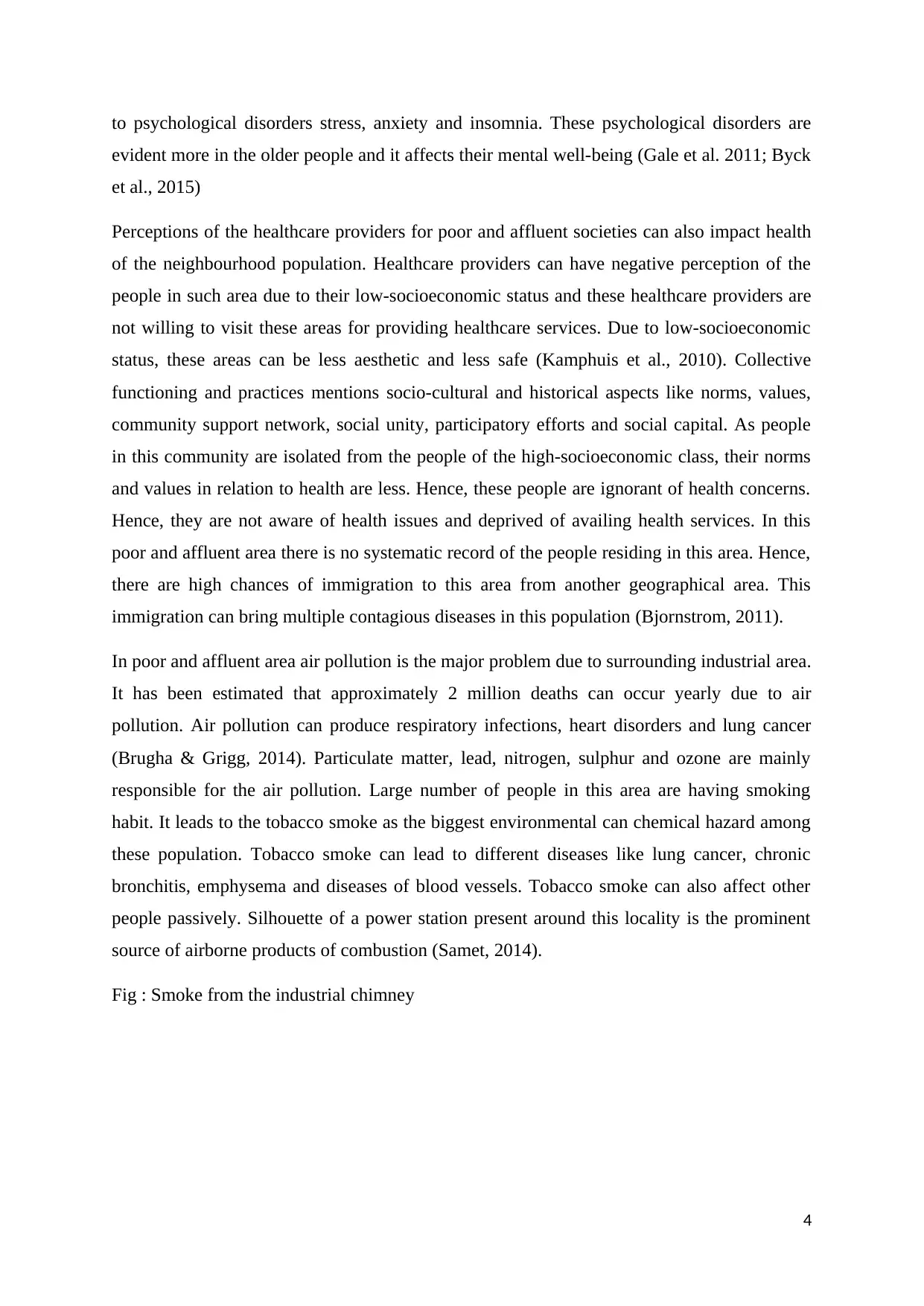
to psychological disorders stress, anxiety and insomnia. These psychological disorders are
evident more in the older people and it affects their mental well-being (Gale et al. 2011; Byck
et al., 2015)
Perceptions of the healthcare providers for poor and affluent societies can also impact health
of the neighbourhood population. Healthcare providers can have negative perception of the
people in such area due to their low-socioeconomic status and these healthcare providers are
not willing to visit these areas for providing healthcare services. Due to low-socioeconomic
status, these areas can be less aesthetic and less safe (Kamphuis et al., 2010). Collective
functioning and practices mentions socio-cultural and historical aspects like norms, values,
community support network, social unity, participatory efforts and social capital. As people
in this community are isolated from the people of the high-socioeconomic class, their norms
and values in relation to health are less. Hence, these people are ignorant of health concerns.
Hence, they are not aware of health issues and deprived of availing health services. In this
poor and affluent area there is no systematic record of the people residing in this area. Hence,
there are high chances of immigration to this area from another geographical area. This
immigration can bring multiple contagious diseases in this population (Bjornstrom, 2011).
In poor and affluent area air pollution is the major problem due to surrounding industrial area.
It has been estimated that approximately 2 million deaths can occur yearly due to air
pollution. Air pollution can produce respiratory infections, heart disorders and lung cancer
(Brugha & Grigg, 2014). Particulate matter, lead, nitrogen, sulphur and ozone are mainly
responsible for the air pollution. Large number of people in this area are having smoking
habit. It leads to the tobacco smoke as the biggest environmental can chemical hazard among
these population. Tobacco smoke can lead to different diseases like lung cancer, chronic
bronchitis, emphysema and diseases of blood vessels. Tobacco smoke can also affect other
people passively. Silhouette of a power station present around this locality is the prominent
source of airborne products of combustion (Samet, 2014).
Fig : Smoke from the industrial chimney
4
evident more in the older people and it affects their mental well-being (Gale et al. 2011; Byck
et al., 2015)
Perceptions of the healthcare providers for poor and affluent societies can also impact health
of the neighbourhood population. Healthcare providers can have negative perception of the
people in such area due to their low-socioeconomic status and these healthcare providers are
not willing to visit these areas for providing healthcare services. Due to low-socioeconomic
status, these areas can be less aesthetic and less safe (Kamphuis et al., 2010). Collective
functioning and practices mentions socio-cultural and historical aspects like norms, values,
community support network, social unity, participatory efforts and social capital. As people
in this community are isolated from the people of the high-socioeconomic class, their norms
and values in relation to health are less. Hence, these people are ignorant of health concerns.
Hence, they are not aware of health issues and deprived of availing health services. In this
poor and affluent area there is no systematic record of the people residing in this area. Hence,
there are high chances of immigration to this area from another geographical area. This
immigration can bring multiple contagious diseases in this population (Bjornstrom, 2011).
In poor and affluent area air pollution is the major problem due to surrounding industrial area.
It has been estimated that approximately 2 million deaths can occur yearly due to air
pollution. Air pollution can produce respiratory infections, heart disorders and lung cancer
(Brugha & Grigg, 2014). Particulate matter, lead, nitrogen, sulphur and ozone are mainly
responsible for the air pollution. Large number of people in this area are having smoking
habit. It leads to the tobacco smoke as the biggest environmental can chemical hazard among
these population. Tobacco smoke can lead to different diseases like lung cancer, chronic
bronchitis, emphysema and diseases of blood vessels. Tobacco smoke can also affect other
people passively. Silhouette of a power station present around this locality is the prominent
source of airborne products of combustion (Samet, 2014).
Fig : Smoke from the industrial chimney
4
Paraphrase This Document
Need a fresh take? Get an instant paraphrase of this document with our AI Paraphraser
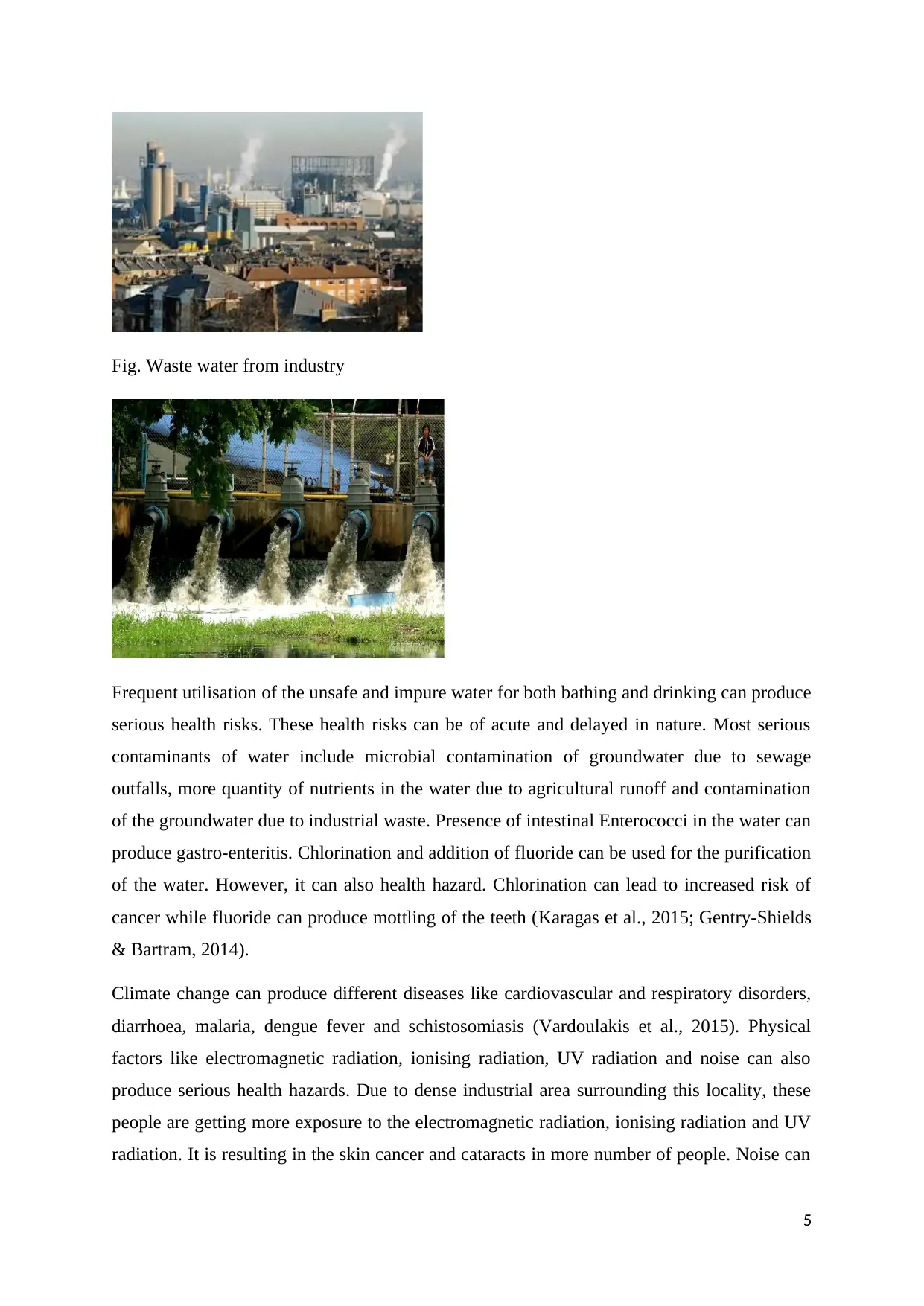
Fig. Waste water from industry
Frequent utilisation of the unsafe and impure water for both bathing and drinking can produce
serious health risks. These health risks can be of acute and delayed in nature. Most serious
contaminants of water include microbial contamination of groundwater due to sewage
outfalls, more quantity of nutrients in the water due to agricultural runoff and contamination
of the groundwater due to industrial waste. Presence of intestinal Enterococci in the water can
produce gastro-enteritis. Chlorination and addition of fluoride can be used for the purification
of the water. However, it can also health hazard. Chlorination can lead to increased risk of
cancer while fluoride can produce mottling of the teeth (Karagas et al., 2015; Gentry-Shields
& Bartram, 2014).
Climate change can produce different diseases like cardiovascular and respiratory disorders,
diarrhoea, malaria, dengue fever and schistosomiasis (Vardoulakis et al., 2015). Physical
factors like electromagnetic radiation, ionising radiation, UV radiation and noise can also
produce serious health hazards. Due to dense industrial area surrounding this locality, these
people are getting more exposure to the electromagnetic radiation, ionising radiation and UV
radiation. It is resulting in the skin cancer and cataracts in more number of people. Noise can
5
Frequent utilisation of the unsafe and impure water for both bathing and drinking can produce
serious health risks. These health risks can be of acute and delayed in nature. Most serious
contaminants of water include microbial contamination of groundwater due to sewage
outfalls, more quantity of nutrients in the water due to agricultural runoff and contamination
of the groundwater due to industrial waste. Presence of intestinal Enterococci in the water can
produce gastro-enteritis. Chlorination and addition of fluoride can be used for the purification
of the water. However, it can also health hazard. Chlorination can lead to increased risk of
cancer while fluoride can produce mottling of the teeth (Karagas et al., 2015; Gentry-Shields
& Bartram, 2014).
Climate change can produce different diseases like cardiovascular and respiratory disorders,
diarrhoea, malaria, dengue fever and schistosomiasis (Vardoulakis et al., 2015). Physical
factors like electromagnetic radiation, ionising radiation, UV radiation and noise can also
produce serious health hazards. Due to dense industrial area surrounding this locality, these
people are getting more exposure to the electromagnetic radiation, ionising radiation and UV
radiation. It is resulting in the skin cancer and cataracts in more number of people. Noise can
5
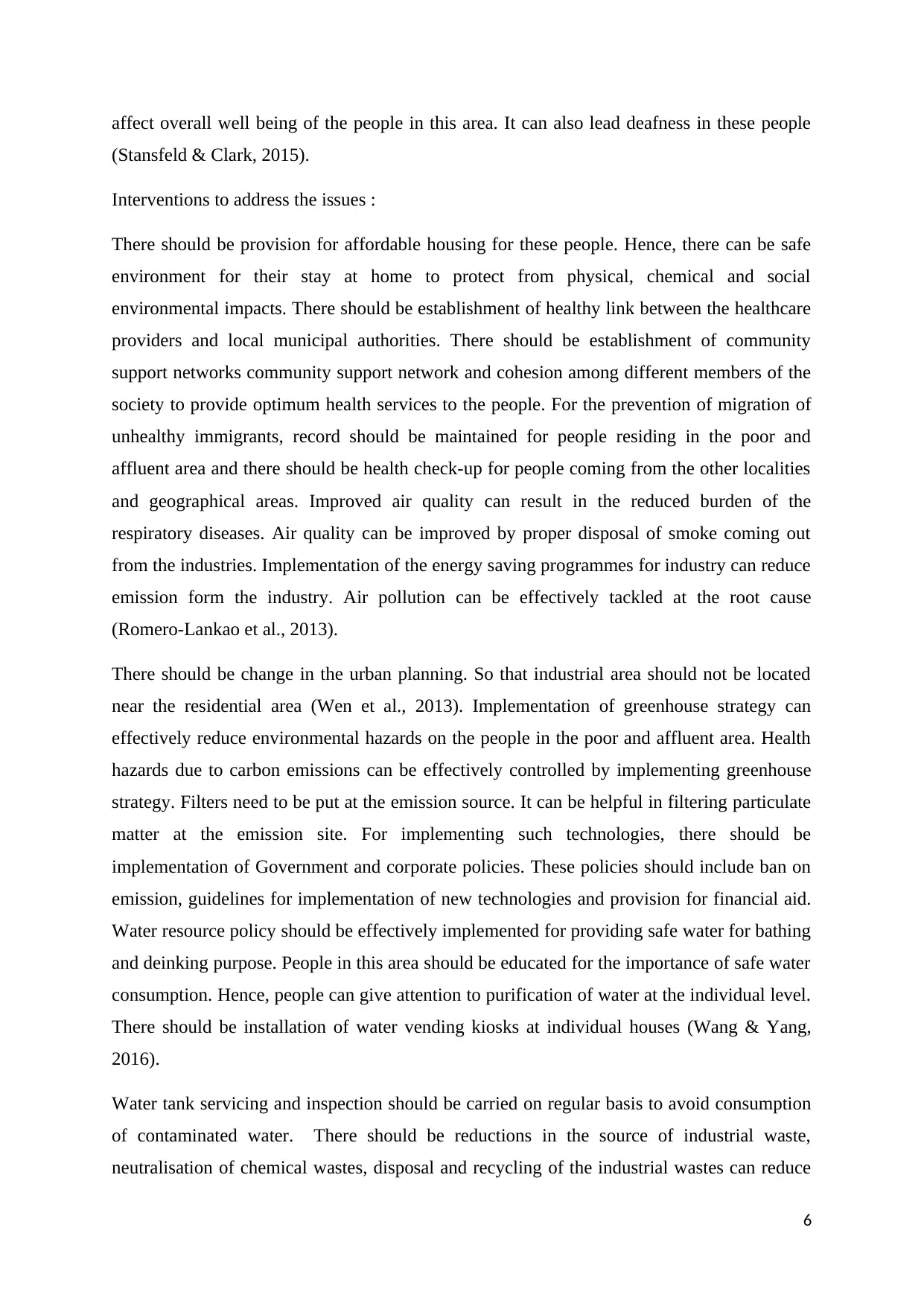
affect overall well being of the people in this area. It can also lead deafness in these people
(Stansfeld & Clark, 2015).
Interventions to address the issues :
There should be provision for affordable housing for these people. Hence, there can be safe
environment for their stay at home to protect from physical, chemical and social
environmental impacts. There should be establishment of healthy link between the healthcare
providers and local municipal authorities. There should be establishment of community
support networks community support network and cohesion among different members of the
society to provide optimum health services to the people. For the prevention of migration of
unhealthy immigrants, record should be maintained for people residing in the poor and
affluent area and there should be health check-up for people coming from the other localities
and geographical areas. Improved air quality can result in the reduced burden of the
respiratory diseases. Air quality can be improved by proper disposal of smoke coming out
from the industries. Implementation of the energy saving programmes for industry can reduce
emission form the industry. Air pollution can be effectively tackled at the root cause
(Romero-Lankao et al., 2013).
There should be change in the urban planning. So that industrial area should not be located
near the residential area (Wen et al., 2013). Implementation of greenhouse strategy can
effectively reduce environmental hazards on the people in the poor and affluent area. Health
hazards due to carbon emissions can be effectively controlled by implementing greenhouse
strategy. Filters need to be put at the emission source. It can be helpful in filtering particulate
matter at the emission site. For implementing such technologies, there should be
implementation of Government and corporate policies. These policies should include ban on
emission, guidelines for implementation of new technologies and provision for financial aid.
Water resource policy should be effectively implemented for providing safe water for bathing
and deinking purpose. People in this area should be educated for the importance of safe water
consumption. Hence, people can give attention to purification of water at the individual level.
There should be installation of water vending kiosks at individual houses (Wang & Yang,
2016).
Water tank servicing and inspection should be carried on regular basis to avoid consumption
of contaminated water. There should be reductions in the source of industrial waste,
neutralisation of chemical wastes, disposal and recycling of the industrial wastes can reduce
6
(Stansfeld & Clark, 2015).
Interventions to address the issues :
There should be provision for affordable housing for these people. Hence, there can be safe
environment for their stay at home to protect from physical, chemical and social
environmental impacts. There should be establishment of healthy link between the healthcare
providers and local municipal authorities. There should be establishment of community
support networks community support network and cohesion among different members of the
society to provide optimum health services to the people. For the prevention of migration of
unhealthy immigrants, record should be maintained for people residing in the poor and
affluent area and there should be health check-up for people coming from the other localities
and geographical areas. Improved air quality can result in the reduced burden of the
respiratory diseases. Air quality can be improved by proper disposal of smoke coming out
from the industries. Implementation of the energy saving programmes for industry can reduce
emission form the industry. Air pollution can be effectively tackled at the root cause
(Romero-Lankao et al., 2013).
There should be change in the urban planning. So that industrial area should not be located
near the residential area (Wen et al., 2013). Implementation of greenhouse strategy can
effectively reduce environmental hazards on the people in the poor and affluent area. Health
hazards due to carbon emissions can be effectively controlled by implementing greenhouse
strategy. Filters need to be put at the emission source. It can be helpful in filtering particulate
matter at the emission site. For implementing such technologies, there should be
implementation of Government and corporate policies. These policies should include ban on
emission, guidelines for implementation of new technologies and provision for financial aid.
Water resource policy should be effectively implemented for providing safe water for bathing
and deinking purpose. People in this area should be educated for the importance of safe water
consumption. Hence, people can give attention to purification of water at the individual level.
There should be installation of water vending kiosks at individual houses (Wang & Yang,
2016).
Water tank servicing and inspection should be carried on regular basis to avoid consumption
of contaminated water. There should be reductions in the source of industrial waste,
neutralisation of chemical wastes, disposal and recycling of the industrial wastes can reduce
6
⊘ This is a preview!⊘
Do you want full access?
Subscribe today to unlock all pages.

Trusted by 1+ million students worldwide
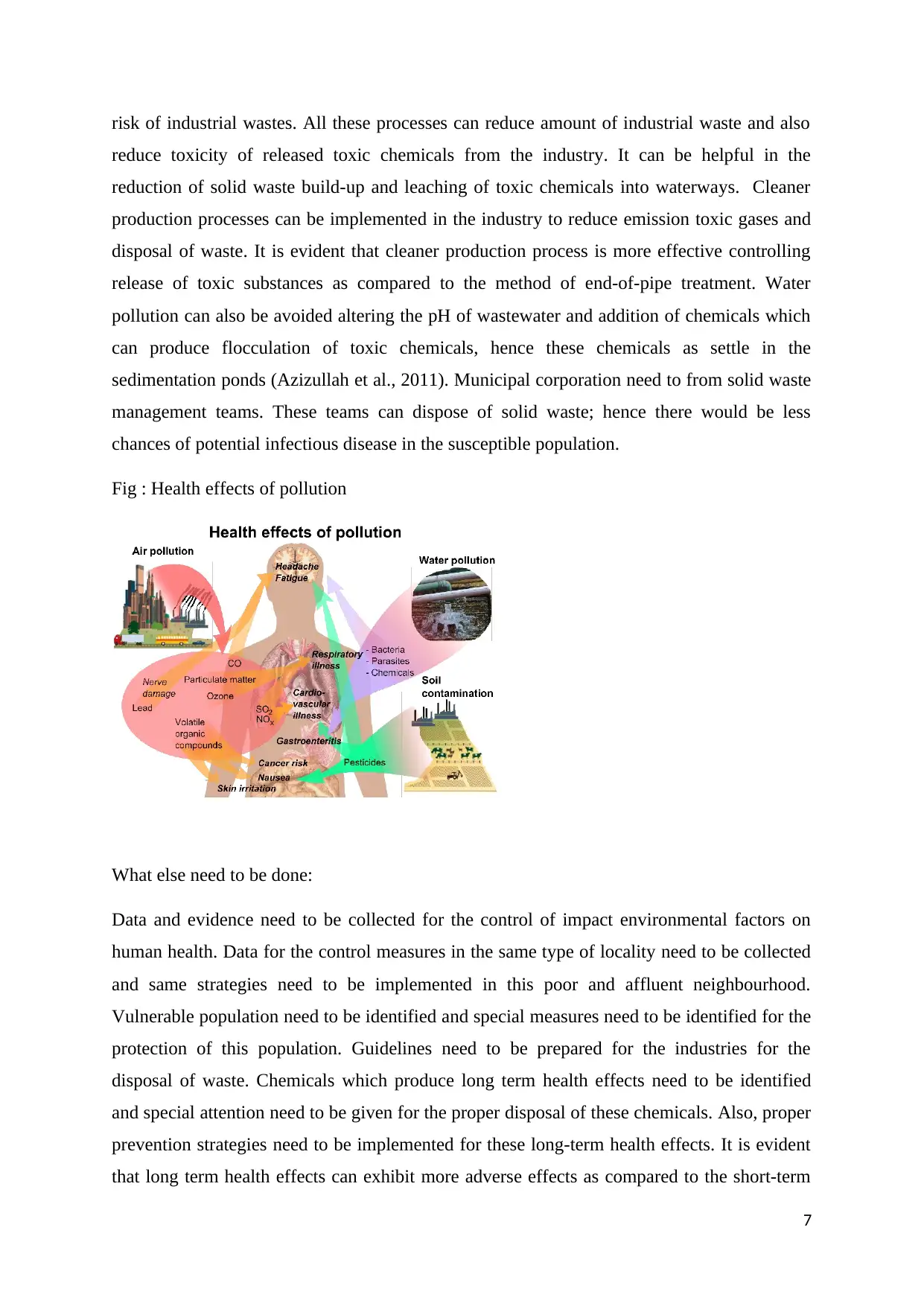
risk of industrial wastes. All these processes can reduce amount of industrial waste and also
reduce toxicity of released toxic chemicals from the industry. It can be helpful in the
reduction of solid waste build-up and leaching of toxic chemicals into waterways. Cleaner
production processes can be implemented in the industry to reduce emission toxic gases and
disposal of waste. It is evident that cleaner production process is more effective controlling
release of toxic substances as compared to the method of end-of-pipe treatment. Water
pollution can also be avoided altering the pH of wastewater and addition of chemicals which
can produce flocculation of toxic chemicals, hence these chemicals as settle in the
sedimentation ponds (Azizullah et al., 2011). Municipal corporation need to from solid waste
management teams. These teams can dispose of solid waste; hence there would be less
chances of potential infectious disease in the susceptible population.
Fig : Health effects of pollution
What else need to be done:
Data and evidence need to be collected for the control of impact environmental factors on
human health. Data for the control measures in the same type of locality need to be collected
and same strategies need to be implemented in this poor and affluent neighbourhood.
Vulnerable population need to be identified and special measures need to be identified for the
protection of this population. Guidelines need to be prepared for the industries for the
disposal of waste. Chemicals which produce long term health effects need to be identified
and special attention need to be given for the proper disposal of these chemicals. Also, proper
prevention strategies need to be implemented for these long-term health effects. It is evident
that long term health effects can exhibit more adverse effects as compared to the short-term
7
reduce toxicity of released toxic chemicals from the industry. It can be helpful in the
reduction of solid waste build-up and leaching of toxic chemicals into waterways. Cleaner
production processes can be implemented in the industry to reduce emission toxic gases and
disposal of waste. It is evident that cleaner production process is more effective controlling
release of toxic substances as compared to the method of end-of-pipe treatment. Water
pollution can also be avoided altering the pH of wastewater and addition of chemicals which
can produce flocculation of toxic chemicals, hence these chemicals as settle in the
sedimentation ponds (Azizullah et al., 2011). Municipal corporation need to from solid waste
management teams. These teams can dispose of solid waste; hence there would be less
chances of potential infectious disease in the susceptible population.
Fig : Health effects of pollution
What else need to be done:
Data and evidence need to be collected for the control of impact environmental factors on
human health. Data for the control measures in the same type of locality need to be collected
and same strategies need to be implemented in this poor and affluent neighbourhood.
Vulnerable population need to be identified and special measures need to be identified for the
protection of this population. Guidelines need to be prepared for the industries for the
disposal of waste. Chemicals which produce long term health effects need to be identified
and special attention need to be given for the proper disposal of these chemicals. Also, proper
prevention strategies need to be implemented for these long-term health effects. It is evident
that long term health effects can exhibit more adverse effects as compared to the short-term
7
Paraphrase This Document
Need a fresh take? Get an instant paraphrase of this document with our AI Paraphraser
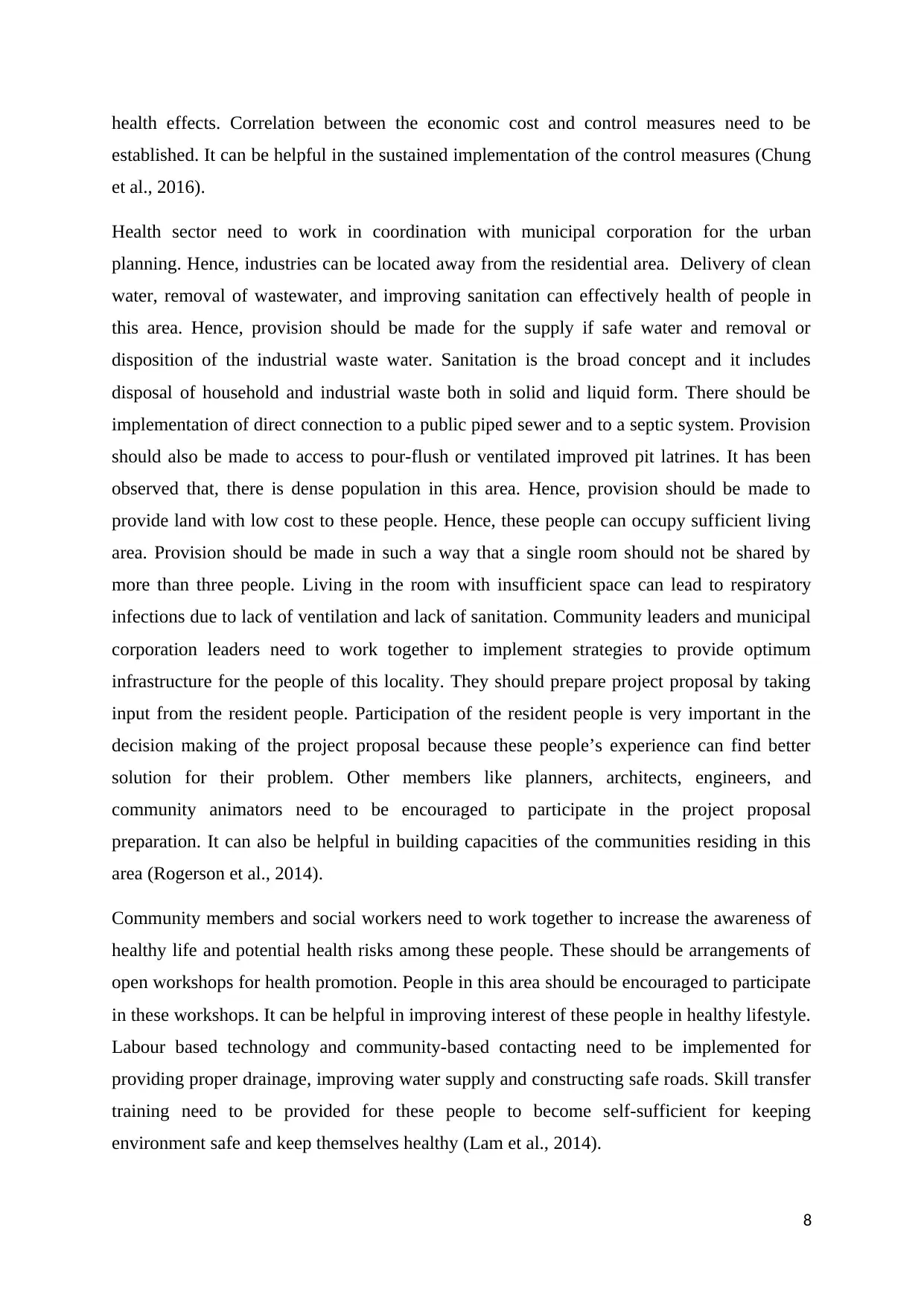
health effects. Correlation between the economic cost and control measures need to be
established. It can be helpful in the sustained implementation of the control measures (Chung
et al., 2016).
Health sector need to work in coordination with municipal corporation for the urban
planning. Hence, industries can be located away from the residential area. Delivery of clean
water, removal of wastewater, and improving sanitation can effectively health of people in
this area. Hence, provision should be made for the supply if safe water and removal or
disposition of the industrial waste water. Sanitation is the broad concept and it includes
disposal of household and industrial waste both in solid and liquid form. There should be
implementation of direct connection to a public piped sewer and to a septic system. Provision
should also be made to access to pour-flush or ventilated improved pit latrines. It has been
observed that, there is dense population in this area. Hence, provision should be made to
provide land with low cost to these people. Hence, these people can occupy sufficient living
area. Provision should be made in such a way that a single room should not be shared by
more than three people. Living in the room with insufficient space can lead to respiratory
infections due to lack of ventilation and lack of sanitation. Community leaders and municipal
corporation leaders need to work together to implement strategies to provide optimum
infrastructure for the people of this locality. They should prepare project proposal by taking
input from the resident people. Participation of the resident people is very important in the
decision making of the project proposal because these people’s experience can find better
solution for their problem. Other members like planners, architects, engineers, and
community animators need to be encouraged to participate in the project proposal
preparation. It can also be helpful in building capacities of the communities residing in this
area (Rogerson et al., 2014).
Community members and social workers need to work together to increase the awareness of
healthy life and potential health risks among these people. These should be arrangements of
open workshops for health promotion. People in this area should be encouraged to participate
in these workshops. It can be helpful in improving interest of these people in healthy lifestyle.
Labour based technology and community-based contacting need to be implemented for
providing proper drainage, improving water supply and constructing safe roads. Skill transfer
training need to be provided for these people to become self-sufficient for keeping
environment safe and keep themselves healthy (Lam et al., 2014).
8
established. It can be helpful in the sustained implementation of the control measures (Chung
et al., 2016).
Health sector need to work in coordination with municipal corporation for the urban
planning. Hence, industries can be located away from the residential area. Delivery of clean
water, removal of wastewater, and improving sanitation can effectively health of people in
this area. Hence, provision should be made for the supply if safe water and removal or
disposition of the industrial waste water. Sanitation is the broad concept and it includes
disposal of household and industrial waste both in solid and liquid form. There should be
implementation of direct connection to a public piped sewer and to a septic system. Provision
should also be made to access to pour-flush or ventilated improved pit latrines. It has been
observed that, there is dense population in this area. Hence, provision should be made to
provide land with low cost to these people. Hence, these people can occupy sufficient living
area. Provision should be made in such a way that a single room should not be shared by
more than three people. Living in the room with insufficient space can lead to respiratory
infections due to lack of ventilation and lack of sanitation. Community leaders and municipal
corporation leaders need to work together to implement strategies to provide optimum
infrastructure for the people of this locality. They should prepare project proposal by taking
input from the resident people. Participation of the resident people is very important in the
decision making of the project proposal because these people’s experience can find better
solution for their problem. Other members like planners, architects, engineers, and
community animators need to be encouraged to participate in the project proposal
preparation. It can also be helpful in building capacities of the communities residing in this
area (Rogerson et al., 2014).
Community members and social workers need to work together to increase the awareness of
healthy life and potential health risks among these people. These should be arrangements of
open workshops for health promotion. People in this area should be encouraged to participate
in these workshops. It can be helpful in improving interest of these people in healthy lifestyle.
Labour based technology and community-based contacting need to be implemented for
providing proper drainage, improving water supply and constructing safe roads. Skill transfer
training need to be provided for these people to become self-sufficient for keeping
environment safe and keep themselves healthy (Lam et al., 2014).
8

9
⊘ This is a preview!⊘
Do you want full access?
Subscribe today to unlock all pages.

Trusted by 1+ million students worldwide
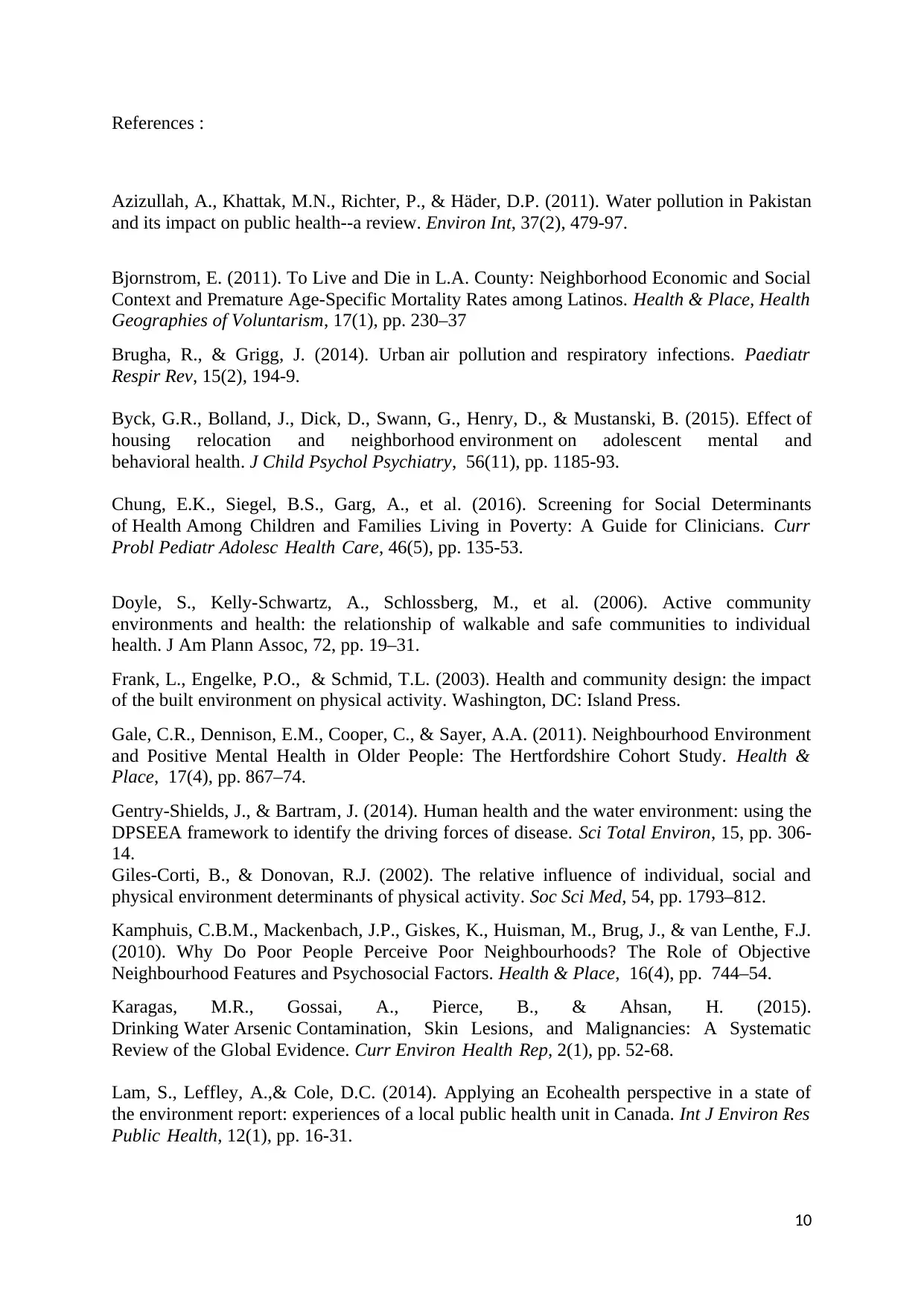
References :
Azizullah, A., Khattak, M.N., Richter, P., & Häder, D.P. (2011). Water pollution in Pakistan
and its impact on public health--a review. Environ Int, 37(2), 479-97.
Bjornstrom, E. (2011). To Live and Die in L.A. County: Neighborhood Economic and Social
Context and Premature Age-Specific Mortality Rates among Latinos. Health & Place, Health
Geographies of Voluntarism, 17(1), pp. 230–37
Brugha, R., & Grigg, J. (2014). Urban air pollution and respiratory infections. Paediatr
Respir Rev, 15(2), 194-9.
Byck, G.R., Bolland, J., Dick, D., Swann, G., Henry, D., & Mustanski, B. (2015). Effect of
housing relocation and neighborhood environment on adolescent mental and
behavioral health. J Child Psychol Psychiatry, 56(11), pp. 1185-93.
Chung, E.K., Siegel, B.S., Garg, A., et al. (2016). Screening for Social Determinants
of Health Among Children and Families Living in Poverty: A Guide for Clinicians. Curr
Probl Pediatr Adolesc Health Care, 46(5), pp. 135-53.
Doyle, S., Kelly-Schwartz, A., Schlossberg, M., et al. (2006). Active community
environments and health: the relationship of walkable and safe communities to individual
health. J Am Plann Assoc, 72, pp. 19–31.
Frank, L., Engelke, P.O., & Schmid, T.L. (2003). Health and community design: the impact
of the built environment on physical activity. Washington, DC: Island Press.
Gale, C.R., Dennison, E.M., Cooper, C., & Sayer, A.A. (2011). Neighbourhood Environment
and Positive Mental Health in Older People: The Hertfordshire Cohort Study. Health &
Place, 17(4), pp. 867–74.
Gentry-Shields, J., & Bartram, J. (2014). Human health and the water environment: using the
DPSEEA framework to identify the driving forces of disease. Sci Total Environ, 15, pp. 306-
14.
Giles-Corti, B., & Donovan, R.J. (2002). The relative influence of individual, social and
physical environment determinants of physical activity. Soc Sci Med, 54, pp. 1793–812.
Kamphuis, C.B.M., Mackenbach, J.P., Giskes, K., Huisman, M., Brug, J., & van Lenthe, F.J.
(2010). Why Do Poor People Perceive Poor Neighbourhoods? The Role of Objective
Neighbourhood Features and Psychosocial Factors. Health & Place, 16(4), pp. 744–54.
Karagas, M.R., Gossai, A., Pierce, B., & Ahsan, H. (2015).
Drinking Water Arsenic Contamination, Skin Lesions, and Malignancies: A Systematic
Review of the Global Evidence. Curr Environ Health Rep, 2(1), pp. 52-68.
Lam, S., Leffley, A.,& Cole, D.C. (2014). Applying an Ecohealth perspective in a state of
the environment report: experiences of a local public health unit in Canada. Int J Environ Res
Public Health, 12(1), pp. 16-31.
10
Azizullah, A., Khattak, M.N., Richter, P., & Häder, D.P. (2011). Water pollution in Pakistan
and its impact on public health--a review. Environ Int, 37(2), 479-97.
Bjornstrom, E. (2011). To Live and Die in L.A. County: Neighborhood Economic and Social
Context and Premature Age-Specific Mortality Rates among Latinos. Health & Place, Health
Geographies of Voluntarism, 17(1), pp. 230–37
Brugha, R., & Grigg, J. (2014). Urban air pollution and respiratory infections. Paediatr
Respir Rev, 15(2), 194-9.
Byck, G.R., Bolland, J., Dick, D., Swann, G., Henry, D., & Mustanski, B. (2015). Effect of
housing relocation and neighborhood environment on adolescent mental and
behavioral health. J Child Psychol Psychiatry, 56(11), pp. 1185-93.
Chung, E.K., Siegel, B.S., Garg, A., et al. (2016). Screening for Social Determinants
of Health Among Children and Families Living in Poverty: A Guide for Clinicians. Curr
Probl Pediatr Adolesc Health Care, 46(5), pp. 135-53.
Doyle, S., Kelly-Schwartz, A., Schlossberg, M., et al. (2006). Active community
environments and health: the relationship of walkable and safe communities to individual
health. J Am Plann Assoc, 72, pp. 19–31.
Frank, L., Engelke, P.O., & Schmid, T.L. (2003). Health and community design: the impact
of the built environment on physical activity. Washington, DC: Island Press.
Gale, C.R., Dennison, E.M., Cooper, C., & Sayer, A.A. (2011). Neighbourhood Environment
and Positive Mental Health in Older People: The Hertfordshire Cohort Study. Health &
Place, 17(4), pp. 867–74.
Gentry-Shields, J., & Bartram, J. (2014). Human health and the water environment: using the
DPSEEA framework to identify the driving forces of disease. Sci Total Environ, 15, pp. 306-
14.
Giles-Corti, B., & Donovan, R.J. (2002). The relative influence of individual, social and
physical environment determinants of physical activity. Soc Sci Med, 54, pp. 1793–812.
Kamphuis, C.B.M., Mackenbach, J.P., Giskes, K., Huisman, M., Brug, J., & van Lenthe, F.J.
(2010). Why Do Poor People Perceive Poor Neighbourhoods? The Role of Objective
Neighbourhood Features and Psychosocial Factors. Health & Place, 16(4), pp. 744–54.
Karagas, M.R., Gossai, A., Pierce, B., & Ahsan, H. (2015).
Drinking Water Arsenic Contamination, Skin Lesions, and Malignancies: A Systematic
Review of the Global Evidence. Curr Environ Health Rep, 2(1), pp. 52-68.
Lam, S., Leffley, A.,& Cole, D.C. (2014). Applying an Ecohealth perspective in a state of
the environment report: experiences of a local public health unit in Canada. Int J Environ Res
Public Health, 12(1), pp. 16-31.
10
Paraphrase This Document
Need a fresh take? Get an instant paraphrase of this document with our AI Paraphraser
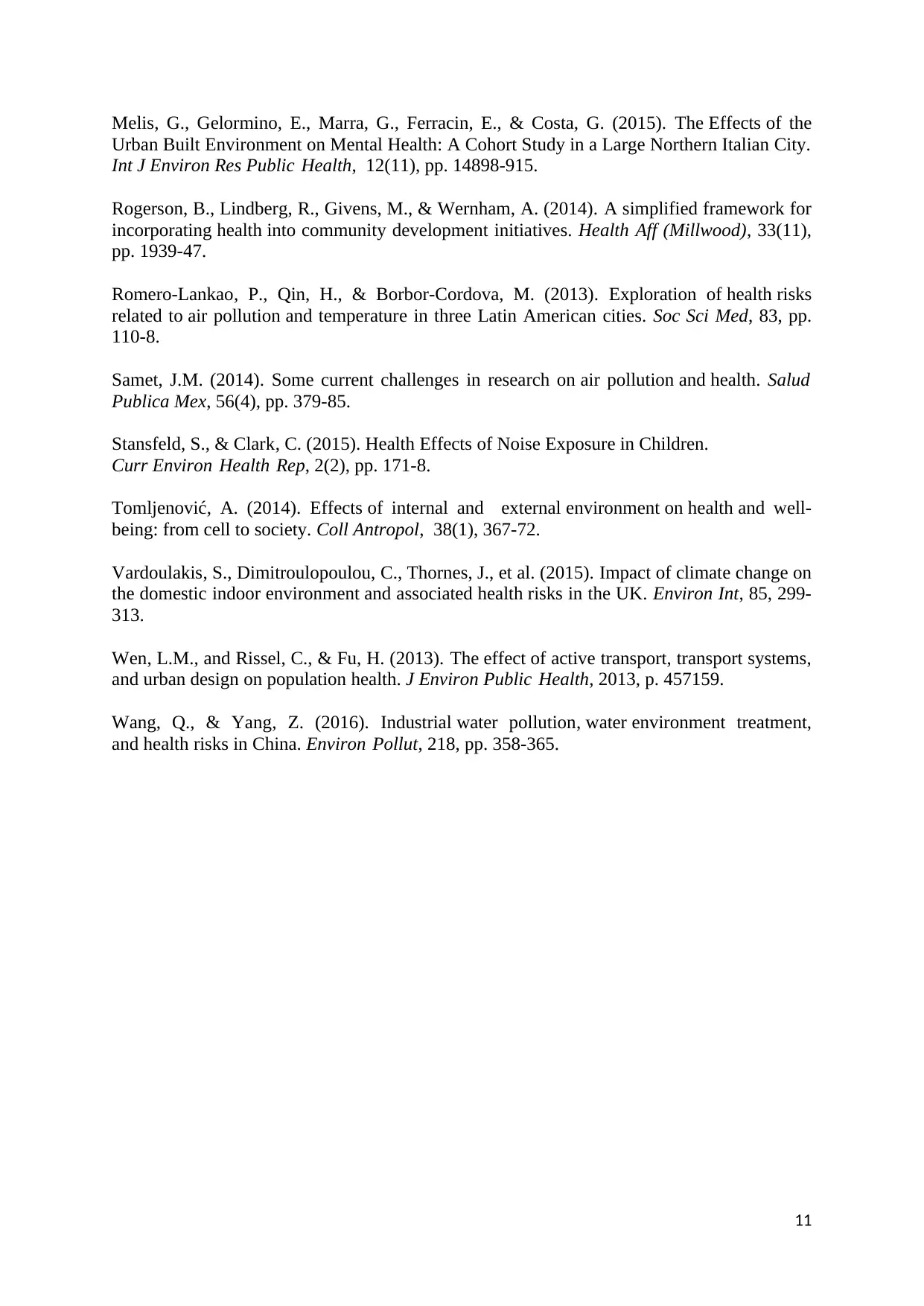
Melis, G., Gelormino, E., Marra, G., Ferracin, E., & Costa, G. (2015). The Effects of the
Urban Built Environment on Mental Health: A Cohort Study in a Large Northern Italian City.
Int J Environ Res Public Health, 12(11), pp. 14898-915.
Rogerson, B., Lindberg, R., Givens, M., & Wernham, A. (2014). A simplified framework for
incorporating health into community development initiatives. Health Aff (Millwood), 33(11),
pp. 1939-47.
Romero-Lankao, P., Qin, H., & Borbor-Cordova, M. (2013). Exploration of health risks
related to air pollution and temperature in three Latin American cities. Soc Sci Med, 83, pp.
110-8.
Samet, J.M. (2014). Some current challenges in research on air pollution and health. Salud
Publica Mex, 56(4), pp. 379-85.
Stansfeld, S., & Clark, C. (2015). Health Effects of Noise Exposure in Children.
Curr Environ Health Rep, 2(2), pp. 171-8.
Tomljenović, A. (2014). Effects of internal and external environment on health and well-
being: from cell to society. Coll Antropol, 38(1), 367-72.
Vardoulakis, S., Dimitroulopoulou, C., Thornes, J., et al. (2015). Impact of climate change on
the domestic indoor environment and associated health risks in the UK. Environ Int, 85, 299-
313.
Wen, L.M., and Rissel, C., & Fu, H. (2013). The effect of active transport, transport systems,
and urban design on population health. J Environ Public Health, 2013, p. 457159.
Wang, Q., & Yang, Z. (2016). Industrial water pollution, water environment treatment,
and health risks in China. Environ Pollut, 218, pp. 358-365.
11
Urban Built Environment on Mental Health: A Cohort Study in a Large Northern Italian City.
Int J Environ Res Public Health, 12(11), pp. 14898-915.
Rogerson, B., Lindberg, R., Givens, M., & Wernham, A. (2014). A simplified framework for
incorporating health into community development initiatives. Health Aff (Millwood), 33(11),
pp. 1939-47.
Romero-Lankao, P., Qin, H., & Borbor-Cordova, M. (2013). Exploration of health risks
related to air pollution and temperature in three Latin American cities. Soc Sci Med, 83, pp.
110-8.
Samet, J.M. (2014). Some current challenges in research on air pollution and health. Salud
Publica Mex, 56(4), pp. 379-85.
Stansfeld, S., & Clark, C. (2015). Health Effects of Noise Exposure in Children.
Curr Environ Health Rep, 2(2), pp. 171-8.
Tomljenović, A. (2014). Effects of internal and external environment on health and well-
being: from cell to society. Coll Antropol, 38(1), 367-72.
Vardoulakis, S., Dimitroulopoulou, C., Thornes, J., et al. (2015). Impact of climate change on
the domestic indoor environment and associated health risks in the UK. Environ Int, 85, 299-
313.
Wen, L.M., and Rissel, C., & Fu, H. (2013). The effect of active transport, transport systems,
and urban design on population health. J Environ Public Health, 2013, p. 457159.
Wang, Q., & Yang, Z. (2016). Industrial water pollution, water environment treatment,
and health risks in China. Environ Pollut, 218, pp. 358-365.
11
1 out of 11
Related Documents
Your All-in-One AI-Powered Toolkit for Academic Success.
+13062052269
info@desklib.com
Available 24*7 on WhatsApp / Email
![[object Object]](/_next/static/media/star-bottom.7253800d.svg)
Unlock your academic potential
Copyright © 2020–2025 A2Z Services. All Rights Reserved. Developed and managed by ZUCOL.


